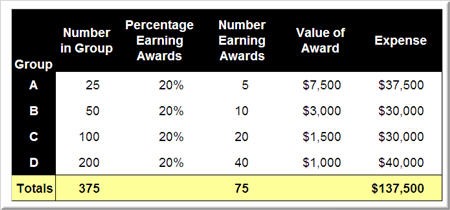There is a common incentive program structure that has been around forever. It’s called “group competition.” In an incentive program that uses group competition, the audience is segmented into groups based on their performance levels (sales, profits, number of customers) and then they compete for a set number of awards within their group. Typically, the award values also vary by group. This structure is used to limit the budget exposure for a client. It is a type of program called a “closed-ended” program vs. an “open-ended” program. If a program is an open-ended program then the number of awards that can be earned is variable – meaning everyone could earn an award if they met the award criteria. With a closed-end program you limit your exposure by limiting the number of award earners.
Full disclosure – I’m not a big fan of competitive award structures – especially for shorter term objectives. I always believe you are better served in the long-run rewarding improvements in the absolute performance of an individual rather than rewarding performance that is relative to others in a group. But I digress.
Group competition has a couple of very important caveats to consider if the structure is going to work at all.
Group Segmentation Criteria
When there are a few superstars as part of the group the other players start to ask, “Can I earn the award? Is there anyway I can compete with the top performers?” If their ability is well below that of the superstars – they will give up. Why play the game if the top people are so good? This is a real problem if you don’t pay attention to the overall performance distribution of the competitive group.
To make it work, you need to segment your groups so they are composed of members with similar performance statistics. The distribution of performance should be pretty narrow in each group if you want there to be some semblance of fairness.
Relative Value of the Award
Another link you may want to review is this study on how people feel “more rewarded” if their award is greater than that of another person. In other words – I feel better if I’m awarded more than another person in the game regardless of the “absolute” value of the award. The difference between the value of my award and theirs is the key element.
On the surface it may seem unfair to award a member of one segment more than another for basically the “same” performance (being in the top 5 of their group.) However, each group contributes differently. The top performer group typically brings in more revenue/profit than the other groups and therefore, you can justify the increased award value. There is a formula for this but that’s a different post.
So, I will feel better about my award if it is more than others – but I won’t play if the others are better players.
Enter Group Competition
Structuring a reward program as a group competition can alleviate these issues.
A chart showing how a competitive grouping scenario sets up could look like this…
As the chart indicates, the same percentage of awards are allocated to each group. However, as you move down the hierarchy, there are progressively more members of each group – decreasing the “odds” of earning. As mentioned, this is done to reward your very top producers – those that continually bring home the bacon – without demotivating the rest of your population. This structure is also very effective in independent distribution channels where participants have a choice of where to buy their product. If someone typically buys all their product from a competitor but sees you award as valuable and attainable, they will “shift” their buying to your product. This “uncovers” their ability to be a good customer that you may never have even seen before.
In addition, the award value increases as you move up in the groupings. This is done to communicate the “relative” value issue. You want the folks in the higher groups to see a real difference in their award versus the others – this leads to a greater feeling of reward.
Pros and Cons
Pros
- Fixed (closed budget) – can’t go over budget – the awards are fixed
- Depending on industry and company culture highlighting standings reports on who’s in which place in each group can create a real uptick in performance
- Uncover buyers that haven’t traditionally bought from you in the past
Cons
- Depending on performance distribution it could be difficult or impossible to create fair competitive groups
- There will be losers – people could double their performance but not earn an award since the outcome is a stack ranking of each person’s performance.
Keys to Success
From a structure standpoint this is important information. The keys in developing a successful competitively structured program are:
- If you have an audience that has very wide ranges of performance – segment them and let them compete within similar performance bands. Don’t let a newbie compete against a seasoned pro.
- Make sure the top awards show a larger marginal increase from the award just below it.
See… not so easy is it.
And I’m just getting warmed up. I could add another 10,000 words on this structure alone – but I’m recovering from a Turkey coma, so I’ll let you off the hook.
photo credit: BrianPirie via photopin (license)






Recent Comments